Holographic metrology is less confounded by the shape of the parts it measures, and offers a unique tool for cost-effectively evaluating optics and other components in high volumes.
MARIE FREEBODY, CONTRIBUTING EDITOR
All optical imaging
systems, from smartphone cameras to extreme-ultraviolet
photolithography optics, are under increasing pressure to support higher resolution, broader spectral range, or higher sensitivity in low-light applications. Such demands are driving optical components and systems to be specified to meet ever tighter tolerances.
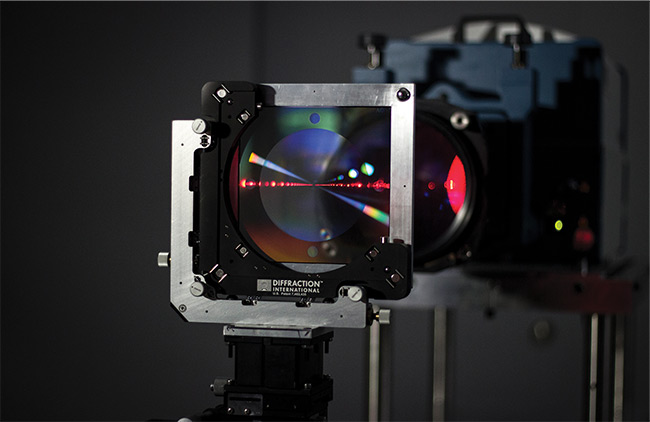
A computer-generated hologram in an alignment mount. Courtesy of AOS.
From the design and manufacture to final assembly and alignment of optical assemblies, precision metrology plays a crucial role in satisfying quality standards throughout the value chain.
“To put it simply, if you can’t measure it, you can’t make it,” said Cory Boone, technical marketing manager at Edmund Optics. “The level of precision required for manufacturing optical elements is much higher compared with most other forms of manufacturing, as imperfections on the level of nanometers, or even angstroms can significantly impact light throughput.”
As calls for improvements to the quality, safety, and reliability of modern optical components have grown steadily in recent years, so have the demands on their manufacture. Many components are highly integrated and complex, but at the same time manufacturing is becoming increasingly customized. This poses a dilemma for quality assurance.
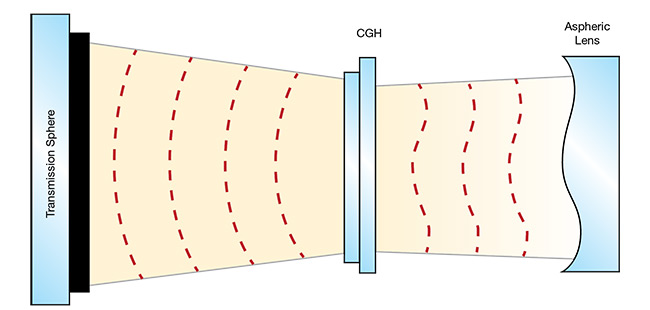
A computer-generated hologram (CGH) converts a spherical wavefront from the transmission sphere in an interferometer to an aspheric wavefront tailored for
measuring a specific asphere design. Courtesy of Edmund Optics.
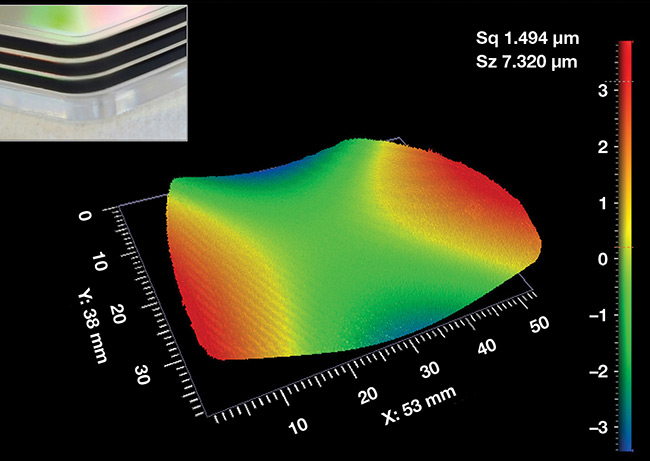
Holography is an enabling technology for the planar waveguides used in digital immersive displays. Courtesy of Zygo Corporation.
“The desire to be careful with the resources available has reinforced the trend toward 100% inspection as early as possible,” said Alexander Bertz, deputy head of product control at the Fraunhofer Institute for Physical Measurement Techniques (IPM). “The trend in metrology follows the trend in manufacturing: faster, more accurate, and more flexible.”
History of holography
After the very early days of practical holography in the 1960s, promising metrology opportunities emerged in rapid succession. The first holographic methods relied on using an interference pattern to reproduce a 3D light field with the depth, parallax, and additional properties of the original scene that was recorded on holographic film.
The transition to digital methods, now known as digital holography, took many years to develop, and improvements in cameras and computers paced the evolution of these techniques. For much of the meantime, less information-intensive optical metrology methods, such as confocal microscopy and optical profilometers, were more attractive.
Today, the digital electronic boundaries to holography have largely fallen away. Holographic metrology methods, such as digital refocusing, are not only competitive but also are increasingly integrated into additional metrology tools.
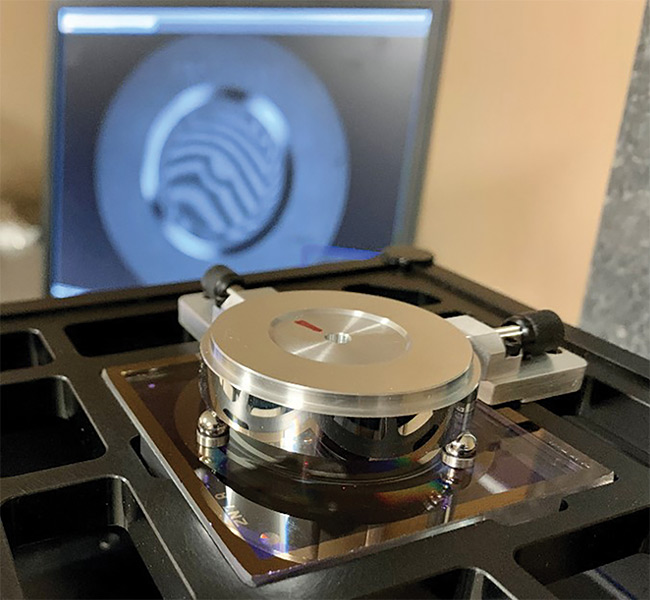
Computer-generated holograms (CGHs) combine with laser interferometry for the precision metrology of aspheres and freeform optical parts. Here, a freeform test mirror mounted and automatically aligned to a CGH enables fast measurements, high throughput, and precise results. Courtesy of Zygo Corporation and Arizona Edmund Optics Optical Metrology.
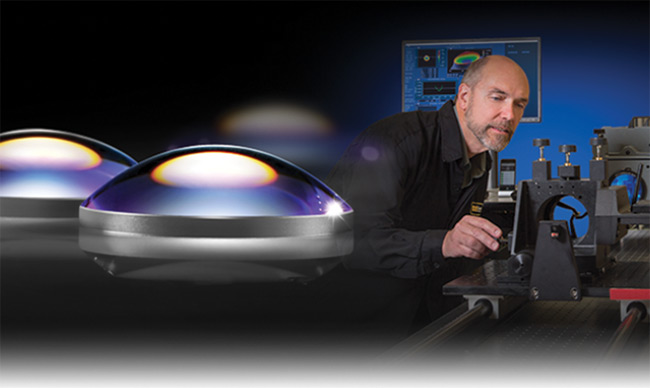
Computer-generated holograms (CGHs) used with interferometers can accurately measure the complex surface shapes of aspheric lenses. Courtesy of Edmund Optics.
“This is particularly the case for
modern interferometers,” said Peter de Groot, chief scientist at Zygo Corpora-
tion. “It is difficult to identify today
an interferometric platform for texture, form measurement, vibration analysis,
or surface structure analysis that is not heavily influenced by holography,” he said.
Aspheres, off-axis, and beyond
Modern interferometers use a digital
camera to record a fringe pattern
produced by the interference between a reference wavefront and test wavefront emanating
from the sample. Numerical methods can then calculate the shape of the surface from the interference pattern.
The drawback of standard interferometers is that they are limited by the surface and wavefront shapes they can measure. Computer-generated holograms (CGHs) extend the capabilities of interferometry by enabling high-precision, full-field
3D measurements in less than one second and, perhaps more significantly, the ability to record complex geometries.
Unlike conventional holograms, CGHs are not interference patterns recorded by superimposing two beams. Instead, the interference pattern is designed entirely on a computer and then directly etched into a substrate using lithography.
This technology circumvents interferometry’s limitations of measuring certain shapes. CGHs can address surface shapes such as cylinders; on- and off-axis conic sections, including paraboloid, hyperboloid, and ellipsoid segments; and aspheric and true freeform surfaces with no symmetry at all.
“The benefits magnify in volume production applications where large quantities of optics must be fabricated to high precision — a single CGH can be used as a reference for large quantities of the same prescription, with a very small cost on a per-unit basis, while also providing
high throughput to further improve costs,” said Tyler Steele, director of
sales and marketing at Arizona Optical Metrology.
If a user already has interferometers on hand, the cost of a CGH is relatively low, for example, between $10,000 and $20,000. The trade-off is that for each unique design, a unique CGH is usually required.
“This makes a lot of sense if the user is fabricating many [optics] of the same design or very high-value one-off optics,” said Steele. “Other methods of metrology
using dedicated instruments that can measure a range of optical surfaces may offer similar capabilities — noncontact, precise, full aperture — but may not be very fast and the instruments themselves can be expensive.”
For example, Aperture Optical Sciences
(AOS) is using CGH to facilitate the manufacture and test of high-performance aspheres for applications in high-energy physics — in which the maximum concentration of energy is desired — and in imaging systems, in which light falling outside of the Airy disk degrades contrast in the image.
“A particular enemy of image quality
is the surface content characterized as mid-spatial frequency error,” said Flemming Tinker, president of AOS. “CGH null correctors can simplify test configurations during manufacturing when mid-spatial error content is most pervasive. Propagation of mid-frequency surface errors adds significant test error, which degrades effectiveness of corrective polishing.”
Correcting mid-spatial error requires not only accuracy in measuring the heights or depths of surface features but also high fidelity in the measurement of these features’ locations so that deterministic finishing techniques can accurately and efficiently target them.
Implementing a short-cavity interferometric null test with a CGH rather than a comparatively long cavity geometric null test can reduce test errors from environmental and mid-spatial frequency surface errors.
CGH null correctors also allow inclusion of convenient alignment features in the hologram, which facilitates repeatable positioning of the workpiece to the test apparatus.
“In such cases, CGH testing contributes to cost-effective manufacturing of high-precision complex aspheres,” Tinker said.
Edmund Optics’ Boone agrees that the up-front cost of CGHs is higher compared with other metrology techniques because production quantity must be factored in, as a unique CGH is usually required for each specific aspheric shape.
“If small quantities of an asphere are being measured, CGH metrology is not a cost-effective option, but this method will lead to significant long-term savings in volume manufacturing,” Boone said. “The setup time of aligning a CGH to interferometer is also longer than other techniques.”
For example, compared with aspheric stitching interferometry (ASI) techniques, using CGHs to measure aspheres can reduce measurement time from 8 to 35 min per lens to as little as 10 s, leading to significant cost savings in higher-volume manufacturing.
“ASI accuracy is highly dependent on shape of the asphere and ASI version but can be as good as λ/10 to λ/20,” Boone said. “ASI accuracy can, however, be as low as λ/4 using older machines. CGH metrology with calibration can achieve accuracies comparable to and even surpassing top-performing ASIs. Both can measure similar departures from best-fit spheres, but the ASI can measure larger diameter convex parts.”
Finally, as with interferometry, CGH remains costly when measuring large-diameter convex parts. This is because the practice requires a large-diameter interferometer or beam expander and a large, and therefore expensive, CGH.
CGH for optical alignment
A unique advantage of CGH metrology is the ability to design and fabricate alignment wavefronts into the CGHs that have near-perfect registration to the metrology wavefront. CGHs can even enable wavefront measurements of optical systems that are not well corrected on their own.
So, for a subsystem intended for use with a second subsystem that produces a specific expected wavefront, it is possible to design a CGH to produce a near-perfect reference wavefront of each subsystem. This approach can then be used to
evaluate the other subsystem independently.
“A CGH is a lithographed optical
element which can accommodate a number of precisely co-aligned patterns to produce optical fiducials in space that register to alignment targets on the test optic or precision testing fixture,” Steele said. “This capability enables both high precision in terms of alignment and also enables a one-time test optic alignment via the testing fixture.”
All optical surfaces require some form of mechanical structure to hold them in place relative to other components in a system. Incorporating reference or fiducial wavefronts with the metrology wavefront in a CGH enables metrology that is relative to mechanical datums of an optical surface.
In the case of a single element, optical surface position and alignment are often prescribed in relation to mechanical features, such as the outer diameter of a lens or explicit mounting features that interface to a frame or structure. Such is the case for many telescope mirrors and lenses, or for the optics within a VR headset.
Many metrology methods provide a measurement of the error in the optical surface itself, but do not provide feedback pertaining to the position of the optical surface in relation to datum structures.
“CGHs and associated alignment strategies can be designed to provide direct feedback for this important aspect of fabrication,” Steele said.
“The benefits of CGH technology have inspired the development of turnkey interferometer platforms designed specifically for manufacturing metrology with an optional CGH,” de Groot said. “At Zygo, we design these systems with the necessary mechanical and software support to provide a complete solution for asphere and freeform metrology.”
Overcoming shadows
Digital holography’s advantages extend to nonoptical parts. Among these advantages is its ability to employ coaxial 3D measurement techniques. Because the incident and reflected rays in these techniques overlap, the measurements are less susceptible to the shadowing problems caused by odd-shaped surfaces that contain holes, steep slopes, or protruding components.
There are many applications in which full-field measurements of such parts have not been possible so far. For example, regarding the measurement of gears, Fraunhofer’s Bertz said, “We also see great potential in the measurement of microstructures in electronics manufacturing or in the measurement of components for fuel cell technology, such as bipolar plates.”
Werner Giessler GmbH, which manufactures precision-turned parts for the automotive sector, is using Fraunhofer IPM’s HoloTop digital multiwavelength holography measurement system for rapid 3D in-line inspection of a key component that is used in piezo-driven fuel injection systems. The part in question is used in 70% of common rail injection systems inside diesel truck engines worldwide, which requires Werner Giessler to manufacture more than 10 million parts per year.
Measuring 3D surfaces with small structures is a challenge for traditional
industrial measurement technology, which can be too imprecise, slow, or insufficiently robust for many in-line measuring assignments.
Werner Giessler is further using Fraunhofer’s HoloTop system to inspect the sealing faces of a conically shaped surface part that must seal at pressures over 2500 bars on the backside of an injection nozzle.
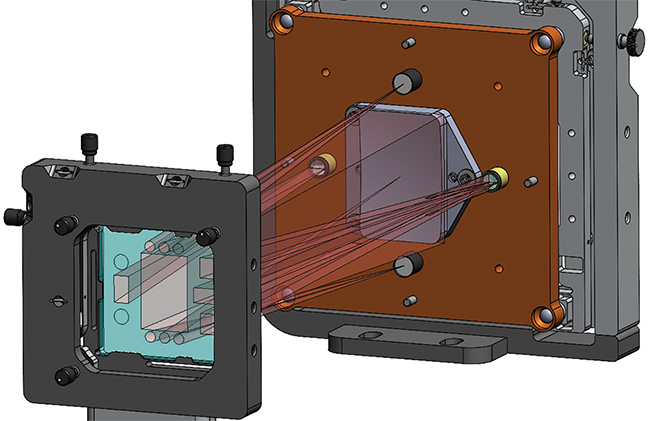
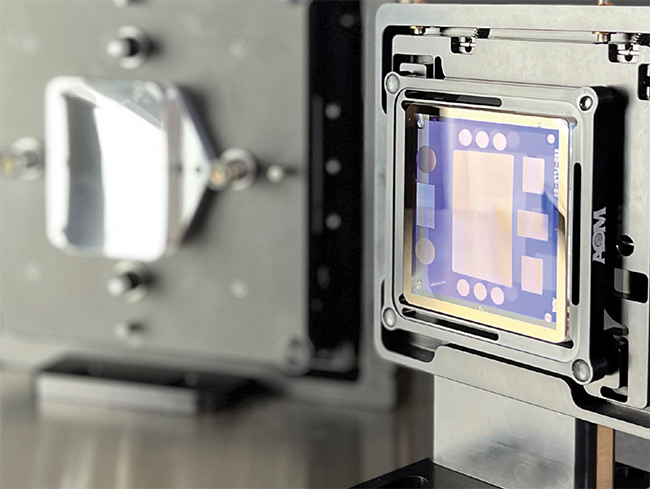
A model of a freeform mirror test (top) using a computer-generated hologram (CGH) shows wavefronts extending to each respective target. A CGH (bottom) for testing freeform mirrors, including multiple alignment patterns, and a freeform test mirror mounted to a metrology reference fixture. Courtesy of Arizona Optical Metrology.
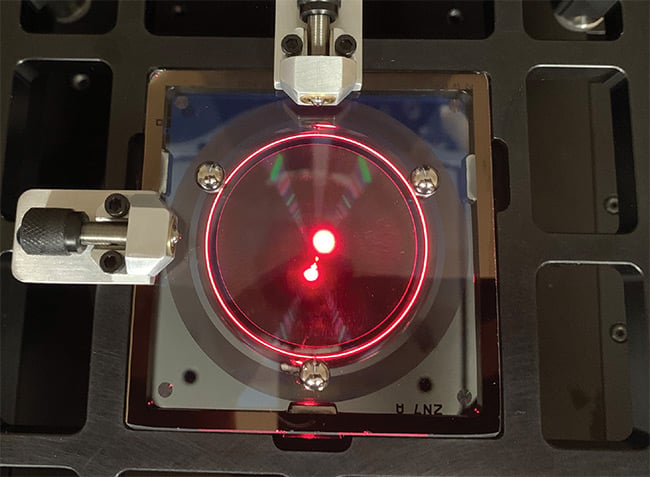

A computer-generated hologram (CGH) for testing aspheric optics with direct-mount features and a laser interferometer shining a test beam through it. Courtesy of Arizona Optical Metrology.
This requires that full-field inspection achieve minimum to maximum tolerances of height deviations at the sealing surface in the range of only 10 µm. Therefore, the repeatability of single-point height measurements must be <1 µm to keep slip and pseudo defect rates sufficiently low to pass standards for the automotive industry. Lateral sampling of the surface must be able to measure defects with a lateral extension of 50 µm.
Fraunhofer’s technology demonstrates the potential of holographic interferometric measurements, even at sampling
rates >100 million points per second (measured over a total area), by achieving single-point repeatability that was
significantly better than 1 µm under production conditions, Bertz said. “Current sensors cover measurement fields between 12 × 12 mm2 to 190 × 150 mm2 in one shot,” he said. “In this context, digital holography offers a high degree of flexibility in terms of adaptability to new applications.”
Complementary technology
Although holography offers advantages,
it is certainly not the solution to all measurement challenges and is best viewed as a complementary technology that enhances a user’s ability to solve a wide range of problems. Technically, it competes with a host of alternative optical measurement techniques such as white light interferometry, confocal microscopy, laser-line triangulation, and stitching
interferometers. And these optical methods all compete with tactile measurement techniques such as contact profilometers. Although profilometer technology is
flexible and proven, it is also partly destructive because the contact measurement changes the examination surface.
Typically, it is reasonable to choose the resolution that safely measures the smallest features that are important to the task while maintaining maximum throughput — or at least the current rate of production. Holography, however, offers certain advantages for select tasks.
“It is not that easy to quantify the benefit without going into detail of a specific application,” Bertz said. “Depending on the field of view and the height differences to measure, digital holography can be an order of magnitude (or even higher) faster than white light interferometry or confocal microscopy.”
Smart future
If the last few years are any measure, then the future of digital holography looks promising. With continuing advancements in computing power, holographic principles are likely to integrate further into conventional optical metrology systems.
Going forward, the prediction is that the demand for optical components for free-space communications, remote sensing, consumer electronics, and the automotive industry will drive growth in CGH and digital holographic metrology techniques. Among the chief prerequisites for any metrology tool, supporting such industries is its ability to support volume production of optics at relatively low cost, as well as its ability to provide the precision and flexibility to measure nearly any surface shape.
Today’s CGHs can provide flexible metrology in a cost-effective manner. But the perceived difficulty in their application, long lead times, and high up-front costs have so far limited broad adoption.
“Improvements in the ease of manufacturing of CGHs would lower the cost barrier of developing CGHs for a given aspheric design, making them a cost-
effective solution at lower volumes,” Boone said. “Then the high throughput of CGH metrology could be leveraged in more situations.”
Alongside existing applications, new fields are expected to develop as fabricators catch on to the advantages offered
by CGHs. They could become useful for applications in which features are designed and fabricated explicitly for
metrology, allowing metrology-polish cycles to be extremely efficient.
Products such as cube-sat constellations for rapid-refresh Earth imaging and free-space communication could benefit, as well as AR/VR headsets. Both appli-
cations require high precision but must remain cost-effective due to large production volumes.